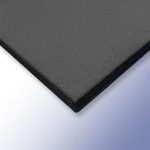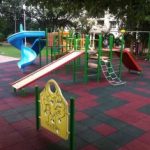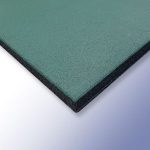Polymax Playground
Polymax have been manufacturing playground flooring for 50 years, understanding that a quality product matters especially when children are involved. The Polymax PLAY tiles have been designed with the safety of children as the number 1 priority.
Polymax playground floors are manufactured using high grade environmentally friendly recycled rubber materials and the premium tiles are designed to be UV resistant, allowing the playground floors to maintain their colour, integrity and finish over a long period of time. The non-premium tiles need to be maintained if they are being placed outside, the Polymax floor care kit is ideal for enhancing the longevity of the tiles.
- Polymax playground floor tiles are simple and safe, offering protection in various outdoor settings, mainly playground areas.
- Polymax Play flooring tiles laid in a community playground.
- Polymax playground floor tiles are simple and safe, offering protection in various outdoor settings, mainly playground areas.
Critical fall height and how it is measured
Polymax PLAY tiles have been tested and certified by the Rubber and Plastics Research Association (RAPRA) for critical fall height proving that they are absorbent enough to limit injury when falling from sizeable heights such as:
- The Top of slides
- Climbing frames
- Swings
- Various other equipment.
A special feature of Polymax safety tiles is the large hollow cone foot, and moulded base, which improves the critical fall height, and helps to absorb much of the energy of a fall further supporting this absorption is a thickness from 20mm to 90mm. This ensures that the surface meets the specified critical fall height, over any size area, and on all installations.
Additionally, the Polymax PLAY tiles also boast ‘anti-slip’ properties, ensuring the safety of children when playing outside after stormy weather.
Measuring Critical Fall Height
The critical fall height is the maximum fall height from which a life-threatening injury would not be expected to arise. According to the ASTM F1292 specification, the performance of a surface is rated in terms of its “critical height”, defined as the drop height from which certain impact criteria are not exceeded. Whilst it is not a legal requirement in the United Kingdom, it is highly recommended to have critical fall height tested on products for the safety of children and for legal purposes, Polymax PLAY tiles adhere to these tests.
With regards to playground flooring, the critical fall height can be measured from a multitude of playground equipment, all measured at different fall points, for example, the measurement for falling off:
- Slides
- Swings
- Climbing Frames
- or a Zipline
could be taken from many points. The slide for example would be measured at its highest point, the middle and also the lowest, however, the playground flooring should always have a critical fall height that surpasses the height of the ‘deck’ (the highest point) of the playground equipment.
Testing Critical Fall Height
Testing for the critical fall height of playground floors commonly takes place in laboratories and research facilities, accurately dropping a projectile from multiple heights onto the flooring for playgrounds, measuring the critical fall height for the specific material. Testing is also carried out in the field using the same method; however, this time the projectile is dropped from specific playground equipment heights revealing the more realistic result for critical fall height tests.
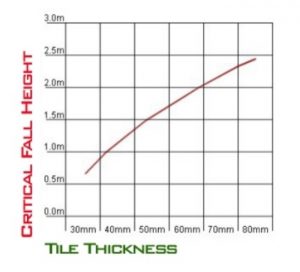
Installation of Polymax PLAY matting.
Ramped Installation
Polymax PLAY tiles can be installed in two ways they can be surface mounted or flush-mounted. Where a good, level sub-base is already in place tiles can be surface mounted, it is recommended to use ramped tiles to avoid blunt edges and trip hazards, using ramped tiles will also aid access for wheelchair users.
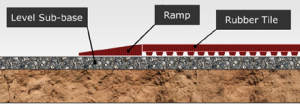
Excavated Installation
Alternatively, the tiles can be flush-mounted, laying in an excavated area, this means the tiles will sit level with the ground providing easy access to playground areas for all ages and abilities. A great benefit of the Polymax PLAY tiles is that when the substrate (ground beneath) is flat adhesives or cement are not required to hold them in place, allowing for an easy install.
When excavating for a flush-mounted application, the overall stone level must be flat. If the groundwork is being installed on an incline, the slope must not exceed 1:10. Alongside this, the internal measurements of the surfacing must extend to a minimum of 1.50 meters beyond any extremity of the playground equipment, this is in accordance with European standard rules.
The excavation must also be a minimum of 150mm PLUS the desired thickness of the playground floor tiles with the PCC edging to be installed in straight lines and at an even plane, bedded and haunched with 100mm class E concrete. Regardless of what groundwork you choose to use, you must leave exactly the right depth to fit the playground floor tiles into the excavated area.
On the base of the excavation must lie a minimum of 75mm M.O.T type one stone which should not exceed 8mm (plus or minus) in any direction under a 3-meter straight edge, this will ensure adequate drainage during and after wet weather.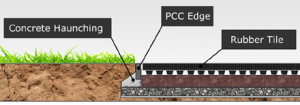
It is often recommended that the compacted stone level is finished below the top line of the PCC edging to allow for the exact thickness of the Playground flooring tiles and 75mm of concrete oversight. Tiles are to be laid tight within the PCC edging and ‘shoehorned’ into position to ensure a secure fit.

